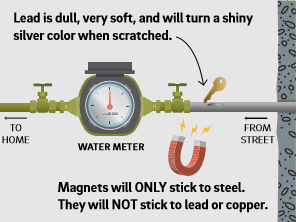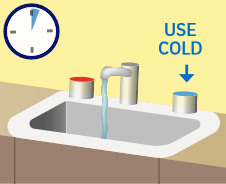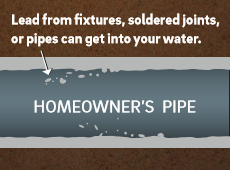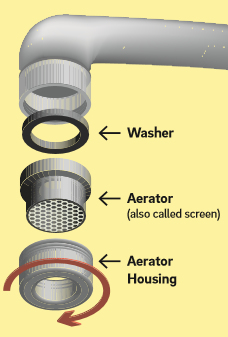My Water
- Status
- Report an Emergency
- What is Flushing?
- Current Flushing Schedule
- Backflow Prevention
- Your Water Source
- ESWA Monitoring
- Water Quality Issues
- Fluoride in Your Water
- Lead Overview
- Water Quality Reports

Lead Overview
The drinking water delivered to your home by ESWA meets or exceeds state and federal water quality standards. When high lead levels are found in tap water, the lead comes from plumbing on the customer's property.Customers are responsible for all home plumbing, and ESWA cannot control what plumbing materials are used beyond the water main and the ESWA portion of the water service later. Homes built before 1950 may have a service line, the pipe connecting home plumbing to the water main in the street, made from lead. Copper pipes inside homes may also be joined by solder containing lead, and older brass pipes, faucets, fittings and valves may have some lead within them.
While the ESWA treats water to make it safer for homes with lead plumbing (corrosion control), there is always a risk of lead getting into water when you have lead in your plumbing.
There are two main ways lead can get into water:
Radioactive Contaminants - When water sits in plumbing made from lead.
Radioactive Contaminants - When pieces of lead plumbing or solder break off inside drinking water pipes.
It is important for customers to check their home for lead plumbing and take steps to ensure safe water if lead is discovered. Whether your home has lead plumbing or not, there are some simple steps you can take to make sure you're getting the cleanest, freshest water possible.
For more information click here to watch a video explanation from the AWWA about lead in your drinking water.
If you do find lead plumbing at your home, see "What To Do If You Have Lead Pipes" below for steps you can take and call our office at 610.258.7181.
PipeInsight (Service Line Inventory):

To comply with requirements of the U.S. EPA’s proposed Lead and Copper Rule Revision (LCRR) by 2024, Easton Suburban Water Authority is working on a project to identify the service line material type on both the company side and the customer side for all of its customers.
ESWA’s PipeInsight is an important program to help identify our customers service materials.
Is your Service Line Made of Lead?
Find out through out Customer Service Line material map. The most common source of lead in tap water is from interior plumbing and the service line entering the home. So being aware of your service line material is important to your health.
Click here to see the map https://experience.arcgis.com/experience/49437931841c4747a38bd4b84a24406f/
If our service material records are not correct, please click here to do the “self-assessment survey” or you can call the office 610.258.7181 and have a technician come out to your home and verify the material.
https://arcg.is/1b4PfP0
The water mains are not made of lead. However, the water service line running from the water main to your home may be made of lead.
Have a Plumber Check for Lead
Have a Plumber Check for Lead - Call a licensed and insured plumber and schedule a lead audit. They can tell you if your service line, solder, or fixtures are made of lead and determine whether plumbing or fixtures should be replaced.Do-It-Yourself Lead Service Line Check
If you know where your water meter is and can access it, you can use these instructions to check your home's service line for lead, or watch the video below. This video was provided by Philadelphia Water Department. It is great video that describes how to check your water pipes for what material they are made of.|
|
Lead can also be found in older brass fixtures and valves and in old solder, where pipes are joined. You can test the water service line where it connects to the water meter in the basement.

Follow these steps:
You will need:Key or a coin
Strong refrigerator magnet
1. Find the water meter in your basement. Look at the pipe that comes through the outside wall of your home and connects to your meter.
2. Carefully scratch the pipe (like you would a lottery ticket) with a key or a coin. Do not use a knife or other sharp tool. Take care not to make a hole in the pipe. If the scratch turns a shiny silver color, it could be lead or steel. NOTE: If pipe is painted, use sandpaper to expose the metal first.
3. Place the magnet on the pipe. If a magnet sticks, it is a steel pipe.

Other ways you can check for lead:
Lead test kits can be purchased at your local hardware or home improvement store. These kits are used to test what the pipe is made from-not the water inside. Look for an EPA recognized kit.A licensed and insured plumber can inspect your pipes and other plumbing for lead. Replacing an older brass faucet or valve may be a simple way to reduce the lead in water.
Check for Lead Solder and Lead in Brass Fixtures - Older solder, the soft metal used to connect copper pipe sections, was often made with lead prior to 1990. If plumbing has been disturbed, small pieces of solder can enter drinking water pipes. You can check solder and plumbing fixtures for lead by using an Environmental Protection Agency (EPA)-approved test kit https://www.epa.gov/lead/lead-test-kits that indicates by a "red dot" if a material has lead in it. These kits can be found at home improvement stores.
For any questions about lead in your water: Call our office at 610.258.7181. Our staff will provide information on water testing, safety tips and replacement options.

If your home is connected to the water main by a water service line that has sections made from lead, a toxic metal, it can impact your health. Follow the steps below to clean out your home plumbing until lead plumbing is replaced. Lead is harmful to everyone. Pregnant women, infants, children under the age of six and adults with high blood pressure and kidney problems are at the most risk.
Instructions for daily cleaning
Run cold water from your tap for at least three minutes. This will give you fresh water from the City water main that is safe for drinking, cooking, making baby formula, feeding your pets, making ice, or watering vegetable gardens.
Tip: You can also bring in fresh water from the City water main by taking a shower, washing dishes, using the clothes washer, or flushing the toilets first.
Best time of day?
First thing in the morningAfter you come home from work, if no one has used the water all day
How often?
Before using water for any cooking or drinkingIf no one has used the water for 6 hours or more
For how long?
At least 3-5 minutesWhen to stop?
This ongoing maintenance is good to do regularly, but especially important in any homes that still have lead pipesCleaning faucet aerators
Don't let poorly maintained home plumbing prevent you from getting the best water available!As water stands in your home's plumbing, lead from the soldered joints and old lead pipes can get into your water. Other debris can build up on the aerator, too. It's important to clean faucet aerators and screens to remove any debris from them.
How often should I clean aerators?
It's recommended you replace the aerator annually, and then clean the aerator twice a year. If the aerator appears to need frequent cleaning or becomes worn, the aerator may need to be replaced more often.
What is a faucet aerator?
It's a device attached to the tip of a faucet. It saves water, filters out debris, and prevents water from splashing. As water flows through the screen, it mixes with air and flows more evenly.
Instructions for cleaning aerators
You will need:Rag
Masking tape
Wrench or Pliers
Old toothbrush
White vinegar
Small plastic tub
Extra aerators
Extra washers
If your faucet has an aerator that you can take off, follow these easy steps:
Place a rag in the sink drain in case you drop any pieces.
If you need to use a wrench or pliers, wrap masking tape around the tips of the wrench or pliers, or on the aerator. Using tape will keep you from scratching the aerator.
Unscrew the aerator.
Separate each part-aerator housing, aerator and rubber washer.
Remove small bits on the screen and other parts.
Soak the parts in white vinegar for a few minutes.
Scrub them with a brush.
If the aerator and rubber washer are in poor condition, replace them.
Put the aerator parts back together.
Screw the aerator back onto the faucet.
Repeat these steps for all faucets.

If you find that you have a lead service line:
Call 610.258.7181 to request to have your water tested for lead or volunteer to have your home take part in ESWA's Lead and Copper Sampling Program.
Contact a licensed and insured plumber to replace your water service lateral
ESWA will come verify ESWA's service lateral from the water main. If we find our side to be lead, we will have it replaced asap. If you have already scheduled a plumber to replace your portion of the service lateral, we will work to schedule our replacement the same time.
Please note that simply having a lead service line does not mean your home's water has high levels of lead. Anti-corrosion control treatment, performed in ESWA has been shown to be effective in keeping lead levels below the U.S. Environmental Protection Agency (EPA) standard of fifteen parts per billion (15ppb).
Where high lead levels in water have been detected, the source has usually been traced to a plumbing fixture. It is always recommended that homeowners remove all potential sources of lead in plumbing when possible.
In addition to replacing lead pipes and plumbing, there are immediate steps you can take to reduce the chances of lead exposure related to water use.
Short-term Steps to Protect Your Family from Lead in Water
Always Drink Fresh Water. Avoid drinking water that has been sitting in your home's pipes for several hours, especially if you have lead plumbing or pipes.If you have not used the water in your home for a few hours, turn on the cold water faucet at the sinks where you get water for drinking and cooking (your kitchen tap and bathroom tap, for example) and let the water run for 2-3 minutes. You should be able to feel the water get colder when fresh water from the water main in the street reaches your tap.
If you find that you have a lead service line:
Programs for lead line replacement
Private Contractors: Customers can contact any licensed and insured plumber and request an estimate for replacing lead service lines and other sources of lead in plumbing. Please note that prices vary according to a number of factors, including how far your home's water meter is from the water main.Make Removing Lead Pipes a Part of Creating a Lead-Free Home: Finding and replacing lead plumbing should be considered as a part of removing all lead from your home. This can be expensive, but removing lead permanently is the safest option. ESWA is committed to helping customers remove lead pipes.
ESWA does not offer any customer assistance programs for replacing customer service laterals at this time.
What is lead?
Lead can be found in many parts of our environment-air, soil, water, and even inside our homes. Lead is a metal that is found naturally all over the world. It can be toxic to humans and animals if it is swallowed or inhaled.Lead exposure is considered a health risk, and all communities should work to make homes lead-free, including in private drinking water pipes. Lead service lines can be unpredictable and pipes that corrode can be major sources of lead exposure.
Where is lead found?
Lead and lead compounds have been used in a wide variety of products, like paint, ceramics, pipes and plumbing materials, gasoline, batteries, and cosmetics. As we've learned more about the dangers of lead, it has been banned in plumbing, paint, gasoline and most consumer products. Because so many homes and businesses in Philadelphia were built before lead was banned, homes can still have lead-based paint and lead plumbing.Why is lead in water a concern for some customers?
Easton Suburban Water Authority delivers water to homes and businesses virtually lead-free. We use corrosion control treatment designed to control lead found in a building's plumbing from entering drinking water. Following state and federal regulations that ensure safe drinking water, cities across the U.S. effectively address lead plumbing issues in the same way: by reducing the natural corrosive qualities of water.Lead can be found in lead pipes, plumbing parts made of brass, solder used to join copper pipe, and faucets that were purchased and installed prior to 2014, when the Environmental Protection Agency (EPA) issued new guidelines for all plumbing under the Safe Drinking Water Act. The biggest source of lead in tap water is old lead pipe. Therefore, it is recommended that homeowners replace any lead pipes as soon possible. Every home has different plumbing and we cannot determine if your water has lead in it unless it has been tested.
What type of lead testing is available?
Easton Suburban Water Authority will test water for lead levels. Call the office to schedule an appointment and testing procedures.What is corrosion control?
Easton Suburban Water Authorities water sources, the Delaware Rivers, is free of lead, However ESWA treats the water to remove lead and other contaminants. This means treated drinking water meets all state and federal water quality standards.The danger of lead getting into water occurs when homes have lead in the plumbing. To protect customers with lead pipes, we treat drinking water with zinc orthophosphate. This coats the inside of pipes, preventing lead from leaching into the water. This is the most accepted practice in the United States.
How can I get my water tested?
Easton Suburban Water Authority will conduct free lead tests for customers. If you believe you have a lead service line in your home and would like to have someone check your water, call our office at 610.258.7181 to schedule an appointment.What is the Lead and Copper Rule and how does it apply to Easton Suburban Water Authority?
This timeline provides an overview of existing and future outreach, testing and lead water service line replacement efforts conducted by the ESWA under the EPA's Lead and Copper Rule (https://www.epa.gov/dwreginfo/lead-and-copper-rule), which regulates how water utilities measure the effectiveness of corrosion control treatment conducted to prevent lead pipes in homes from breaking down. Read this to learn about our testing program.How do I make sure I'm getting the freshest water from ESWA's water mains?
Flush your pipes before drinking, and only use cold water for cooking and drinking. Anytime the water has not been used for several hours, flush cold water pipes by running the water for a few minutes until it becomes cold.Consider replacing lead-containing plumbing fixtures. The Safe Drinking Water Act (SDWA) now requires that only lead-free pipes, solder or flux be used in the installation or repair of any plumbing used to provide water for human consumption. The EPA currently states that plumbing fittings and fixtures (such as kitchen and bathroom faucets) should be certified according to NSF/ANSI 372 NSF/ANSI Standard 61 for lead reduction.
How do I know if I have lead pipes?
With thousands of properties in ESWA's service territory, we only have records of service lateral materials for a portion of these service laterals. We estimate locations and areas that are possible lead, but not certain without digging down to water service lateral. Customers can help us determine the likelihood of their home having a lead pipe that connects to the water main by finding out if their home for lead service laterals.If your water service was replaced after 1991, the replaced section should not be lead.
If you can, call a licensed and registered plumber and have them look at your service line. They can tell you if it is made from lead and give you an estimate for replacement.How can I test my home's drinking water?
Testing your home's drinking water is the only way to confirm if lead is present. Easton Suburban Water Authority (ESWA), like most water providers, tests for lead at a number of homes as a regular part of water monitoring. These tests give a system-wide picture of whether or not corrosion is being controlled, but they do not reflect conditions at each home. Since each home has different plumbing, pipes and materials, test results are likely to be different for each home.Because providing our customers with safe, clean drinking water is our core mission, ESWA does more than follow EPA and Pa. Dept. of Environmental Protection (PADEP) regulations for the testing of lead in tap water.
In addition to routine water quality monitoring, source water protection, and effective water treatment that ensures the water coming into homes meets or exceeds all state and federal quality standards, we offer on-demand testing year-round for customers with concerns about lead in their tap water.
If we test your tap water and find lead levels higher than 15 parts per billion (15 ppb), ESWA will offer help in locating possible sources of lead in your plumbing.
How Testing for Customers Works
When customers concerned about lead call 610.258.7181, our Customer Service Representatives will schedule a visit to the home so that a sample can be collected from the tap. This is the only way to tell if there is a lead issue within the customer's home plumbing.Once a sample is collected, ESWA's water quality specialists will send the samples to a water testing lab, upon testing ESWA will provide customers with the results. If there is an issue, ESWA returns to the home to help identify the source of lead. Once the source of lead is found, we can recommend options for reducing the lead. These free services are provided as a part of our mission to deliver safe water to all customers and are not part of regulatory testing required under the EPA's Lead and Copper Rule.
Testing under the Lead and Copper Rule Regulation
Water providers like ESWA are required by law to test the water system for lead every three years. This testing is designed to ensure that corrosion control treatment is working. Testing has shown that corrosion control treatment is effective and keeps levels of lead in water below EPA standards in most homes with service pipes made of lead or other lead plumbing. Some homes without a water service pipe made of lead may still be at risk for elevated lead levels because of loose lead solder or older brass valves containing lead. All customers should take time to check pipes for lead.
Philadelphia Water Department created an excellent video on how flush your water pipe to get fresh water. Watch this video - that shows this daily cleaning routine.
|
|
Tip: The further your home is from the water main, the longer it will take to bring in fresh water. While this may seem wasteful, most home pipes can be cleared by running just a few gallons through the tap.
Other household water uses like washing clothes, showering, or flushing the toilet are also good ways to bring fresh water from our system into your home plumbing.
Even if you do not have lead plumbing in your house, water may become stale after sitting in your home plumbing for several hours. Running your tap for a short period of time allows you to use the fresh, cold water in the water mains for drinking and cooking.
Regularly Clean Your Faucet Aerator - Small pieces of loose lead solder or lead scale and flakes from old pipes can get trapped on the screen inside your faucet. Not all faucets have ready access to screens and aerators, so follow instructions provided by the faucet manufacturer. Faucets are now required to be lead-free in order to be sold in the store.
Because lead can be found in home plumbing, it's important for homeowners to check their pipes.